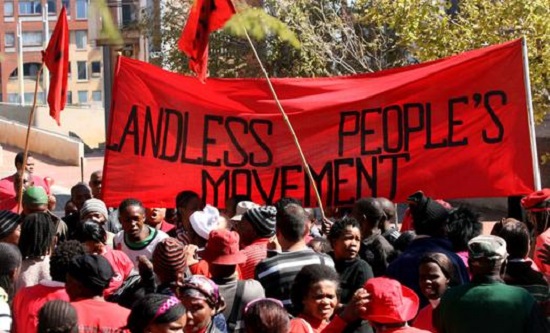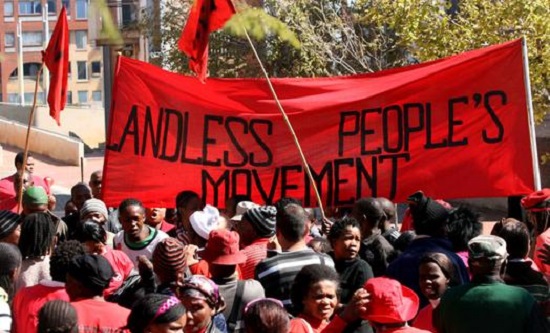
The question of land remains unresolved in South Africa 24 years after the official end of apartheid. Apartheid was a system of separate and racist ‘development’, with black South Africans brutally dispossessed and denied access to land, infrastructure and resources, while their white counterparts were given preferential treatment and access to the economy. On 27 February 2018, the National Assembly decided to review the property clause, Section 25 of the 1996 Constitution to allow ‘land expropriation without compensation’. This followed the decision by the governing African National Congress (ANC) at its December 2017 conference, to implement a constitutional amendment to Section 25, provided it was ‘sustainable and did not harm the agricultural sector or the economy’. In 2016, a law was passed allowing the state to expropriate land in the ‘public interest’. Section 25 of the constitution, itself a compromise with imperialism, only allows for land expropriation for a ‘public purpose or in the public interest’, hence the need to amend the constitution to allow expropriation without compensation.
In 1994, the ANC said it would transfer 30% of white-owned commercial farmland to black farmers by 1999, but so far only 9.7% has been redistributed (Institute of Poverty, Land and Agrarian Studies). Land redistribution has not been a priority for the ANC which has been aligned with imperialism since it came to power in 1994.
By following a capitalist ‘willing buyer, willing seller’ model, the ANC has poured billions into the pockets of white farmers, who have predictably inflated the asking prices of land. These farms are mired in debt and with commercial banks (62%) and the Land Bank (27%) holding most of the debt, the ANC’s land reform has simply transferred state funds to private banks via landowners. More radical sections of the ANC have split away forming a new party, the economic freedom fighters (EFF) who have made land ‘expropriation without compensation’ a major issue in the coming 2019 elections. However, what is important is not expropriation of white farmers per se but rather state control of national land for the productive use for all of society, equal access to productive land and vital post-settlement support ensuring security of tenure, and not merely transfer of land to black political elites.
The land issue has returned to the top of the domestic political agenda due to rising rampant poverty, unemployment and homelessness, which has led to an increase of land occupations. There were over 70 such occupations between 2013-2018. The legacy of apartheid persists with social and economic inequality preserved: white South Africans make up 9-10% of the population but own 95% of national wealth and 73% of land.
Farms and agricultural holdings comprise 97% of the 121.9m hectares of the nation’s total area. 77% of all land (93.9m ha) is privately owned, the state owns only 14% (Department of Rural Development and Land Reform). A 2017 DRDLR audit on registered land (94% of total land, 114.2m ha) dealing only with privately owned land (93.9m ha), showed trusts (31%, 29.3m ha), companies (25%, 23.2m ha) and individuals (39%, 37m ha) owned most of registered land. Of the 37m ha owned by individuals, non-whites owned 24% (blacks 4%) and white people 72% of this privately-owned (registered) land. However, these same individuals owned most of the trusts and companies, meaning that 7% of the population owned 97% of the registered land (111 m ha) which is 91% of all land.
This audit shows that while blacks own 1.2% of all land, whites owned 73%. But with corporate interests capturing almost 30% of all South African land, the focus on white rural farms by the ANC government, media and the EFF, is a diversion. All the land must be nationalised and redistributed according to the needs of the economy as a whole.
65.7% of all South Africans (37.7m people) live in urban areas (3% of total land). The demand for land and most land occupations are taking place in urban areas. 11% of urban households are ’informal’, without water, sanitation or legal electricity connection, facing constant police violence, eviction and displacement. In communal mining areas, commercial farms and informal settlements, black people are being pushed off the land. Expropriation of land may target black people more than white landowners, as evidenced by the 2010 World Cup, where black families were moved out to make way for railways and stadia, only to be still living in transit camps 8 years on. The struggle over land is not a question of seizing ‘white farms’ but of seizing back all the stolen land (corporate, rural and urban) for the inclusion of the oppressed and marginalised into the country’s economy. It is a struggle against the ANC itself and its opportunistic attempts to use the land issue to gain votes in the 2019 elections.
Lies, misinformation and hysteria has accompanied the ANC announcement, with ironic claims of land grabs, threats to food security, investors being spooked, and spurious comparisons to Zimbabwe and Venezuela, culminating in a 23 August tweet from US President Donald Trump claiming ‘large scale killings of [white] farmers’. There were 74 murders in 2016-2017 of farm workers of all race groups, and 47 murders in 2017-2018, the lowest in 20 years. There were over 19,000 murders in South Africa between 2016-2017. There’s no evidence to suggest that farmers as a group suffer more attacks than any other demographic in the country. Investment in state-owned and leased forestry industry land and in special economic zones, where land is jointly owned, shows the hysteria over investors taking flight due to state land ownership is pure mythology.
The ANC’s ‘willing buyer, willing seller’ land redistribution model which has failed to deliver, actually copied Zimbabwe’s 1980 Lancaster House agreement, imposed by Britain, and premised on market-led land purchases from white landowners, and ‘sunset clauses’ that prevented the Zimbabwean government from compulsory land acquisitions, and based on a ‘willing buyer, willing seller’ principle whereby Zimbabwe promised to ‘pay promptly adequate compensation’. This also failed in Zimbabwe, leading to popular uprisings whereby land was forcefully occupied and subsequently parcelled out in a corrupt and disorderly, fast-tracked process by a poorly-prepared, opportunistic state (for whom land redistribution was not a priority but a political card to play). There was no security of tenure, no clear criteria for the allocation of land and little structured support for new allocatees.
Zimbabwe’s economic decline was caused mainly by the World Bank-imposed 1991 structural adjustment program and resulting economic crisis, as well as US and British sanctions determined to destroy Zimbabwe’s economy and punish Mugabe for daring to be independent. The ANC willingly accepted the neo-colonial ‘willing buyer, willing seller’ model whereas Zimbabwe had it imposed on it by British imperialism.
South Africa is the most unequal country in the world, with over 55% (31 m people) below the national poverty line, living on $75 a month. 1% of South Africans own 70.9% of the country’s wealth, the bottom 60% own 7%. Unemployment was 27.7% in 2017 while youth unemployment was 38.6%, and up to 50% in some areas. 30% of black South Africans were unemployed in 2017 compared with 6.7% of whites. According to World Bank director Paul Noumba Um, ‘people at the bottom in South Africa‚ they get wages comparable to the people who live in Bangladesh…the top 10%‚ they live like in Austria. So it’s a very high level even by European…or even by U.S. standards. And we are talking just about employees…not the super-rich who are earning income from factories or property or other investments.
Land nationalisation and redistribution now!




